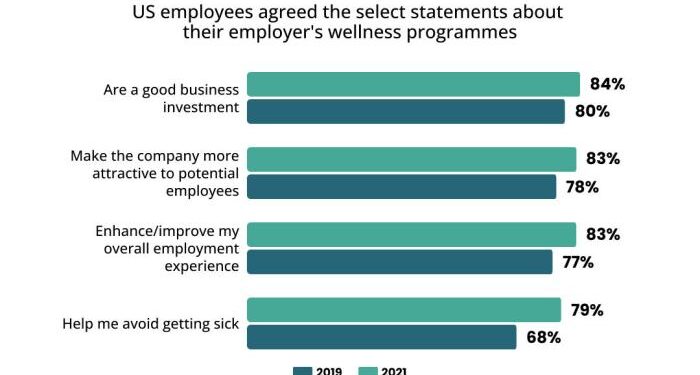Exploring the realm of Workplace wellness programs that boost productivity, this introduction sets the stage for a deep dive into how these programs can transform workplaces and elevate employee performance. From defining the core objectives to highlighting the crucial impact on employee well-being, this overview promises an enlightening journey through the world of workplace wellness initiatives.
As we unravel the benefits, implementation strategies, and measurement techniques of these programs, a holistic understanding of their significance in fostering a healthy and productive work environment will emerge.
Overview of Workplace Wellness Programs

Workplace wellness programs are initiatives implemented by companies to promote the health and well-being of their employees. The primary objectives of these programs are to improve overall employee health, reduce stress, increase engagement, and boost productivity in the workplace. By focusing on physical, mental, and emotional well-being, workplace wellness programs aim to create a positive and supportive work environment.
Importance of Workplace Wellness Programs
Workplace wellness programs play a crucial role in enhancing productivity within organizations. When employees are healthy and feel supported, they are more likely to be engaged, motivated, and focused at work. By providing resources and activities that promote well-being, companies can reduce absenteeism, improve job satisfaction, and ultimately increase productivity levels.
- Regular exercise programs: Offering fitness classes, gym memberships, or on-site workout facilities can help employees stay active and improve their physical health.
- Healthy eating initiatives: Providing nutritious snacks, organizing cooking workshops, or offering healthy meal options can support employees in making better food choices and maintaining a balanced diet.
- Mental health support: Offering counseling services, stress management workshops, or mindfulness training can help employees cope with stress, anxiety, and other mental health issues.
- Work-life balance programs: Promoting flexible work schedules, remote work options, or time management workshops can help employees achieve a better balance between their professional and personal lives.
Benefits of Workplace Wellness Programs
Workplace wellness programs offer a range of benefits that can significantly enhance productivity and overall employee satisfaction.
Improved Physical Health
- Regular exercise and healthy eating habits promoted by these programs can lead to reduced healthcare costs and fewer sick days taken by employees.
- According to a study by the American Journal of Health Promotion, wellness programs can result in a 25% decrease in absenteeism and healthcare costs.
Reduced Stress Levels
- Wellness programs often include stress management techniques such as yoga or meditation, which can help employees cope better with work-related stress.
- Research from the Journal of Occupational and Environmental Medicine shows that stress levels can decrease by 20% with the implementation of workplace wellness programs.
Increased Morale and Job Satisfaction
- When employees feel supported in their well-being, they are more likely to be satisfied with their jobs and have higher morale.
- Studies have shown that companies with wellness programs experience a 10-30% increase in employee morale and job satisfaction.
Implementing Effective Workplace Wellness Programs
Implementing workplace wellness programs requires careful planning and execution to ensure their success. These programs are essential for improving employee well-being and productivity in the workplace.
Designing and Implementing a Successful Workplace Wellness Program
- Conduct a needs assessment to understand the specific health needs and interests of employees.
- Create a wellness committee with representatives from different departments to ensure diverse perspectives and ideas.
- Develop a comprehensive wellness program that includes physical fitness activities, mental health support, nutritional guidance, and stress management resources.
- Evaluate the program regularly to assess its effectiveness and make necessary adjustments based on feedback from participants.
Strategies for Engaging Employees in Wellness Initiatives
- Communicate the benefits of the wellness program clearly to employees to increase their motivation to participate.
- Offer flexible scheduling for wellness activities to accommodate different work schedules.
- Create a supportive and inclusive environment where employees feel comfortable taking part in wellness initiatives.
Examples of Incentives to Encourage Participation
- Provide rewards such as gift cards, extra paid time off, or wellness-themed merchandise for employees who actively engage in the program.
- Organize friendly competitions or challenges with prizes for achieving wellness goals.
- Offer discounted gym memberships or healthy snack options in the workplace as incentives for participation.
Role of Leadership Support in Promoting a Culture of Wellness
- Leadership support is crucial for the success of workplace wellness programs as it sets the tone for the entire organization.
- Encourage top-level executives to participate in wellness activities to lead by example and show their commitment to employee well-being.
- Allocate resources and budget for wellness initiatives to demonstrate the organization's investment in the health and happiness of its employees.
Measuring the Impact of Workplace Wellness Programs
Measuring the impact of workplace wellness programs is crucial to understanding their effectiveness in boosting productivity and employee well-being.
Identifying Key Performance Indicators (KPIs)
- Employee absenteeism rates
- Employee engagement levels
- Healthcare cost savings
- Productivity metrics
Collecting Data and Feedback
- Conduct surveys and questionnaires to gather employee feedback
- Utilize health screenings and biometric data for quantitative measurements
- Analyze participation rates in wellness activities
Analyzing Data for Impact Assessment
- Compare baseline data with post-program data to measure changes
- Look for correlations between wellness program participation and productivity metrics
- Utilize tools like trend analysis to track long-term impact
Adjusting and Improving Wellness Programs
- Use feedback from employees to make targeted improvements
- Implement new initiatives based on data analysis to address specific needs
- Regularly review and adjust wellness programs to ensure ongoing effectiveness
Final Conclusion

In conclusion, Workplace wellness programs that boost productivity stand as pillars of organizational success, nurturing a harmonious blend of employee health and enhanced performance. By embracing these programs, companies can cultivate a culture of well-being that propels both individuals and the organization towards greater heights of achievement.
FAQ Overview
How do workplace wellness programs contribute to increased productivity?
Workplace wellness programs enhance productivity by improving employee health, reducing stress levels, and fostering a positive work environment that promotes focus and engagement.
What are some creative incentives that can be offered to encourage participation in wellness programs?
Examples of incentives include gift cards, extra paid time off, wellness challenges with rewards, or subsidies for gym memberships.
How can companies measure the success of their workplace wellness programs?
Key performance indicators (KPIs) such as reduced absenteeism rates, increased productivity levels, and improved employee satisfaction surveys can be used to gauge the effectiveness of these programs.



